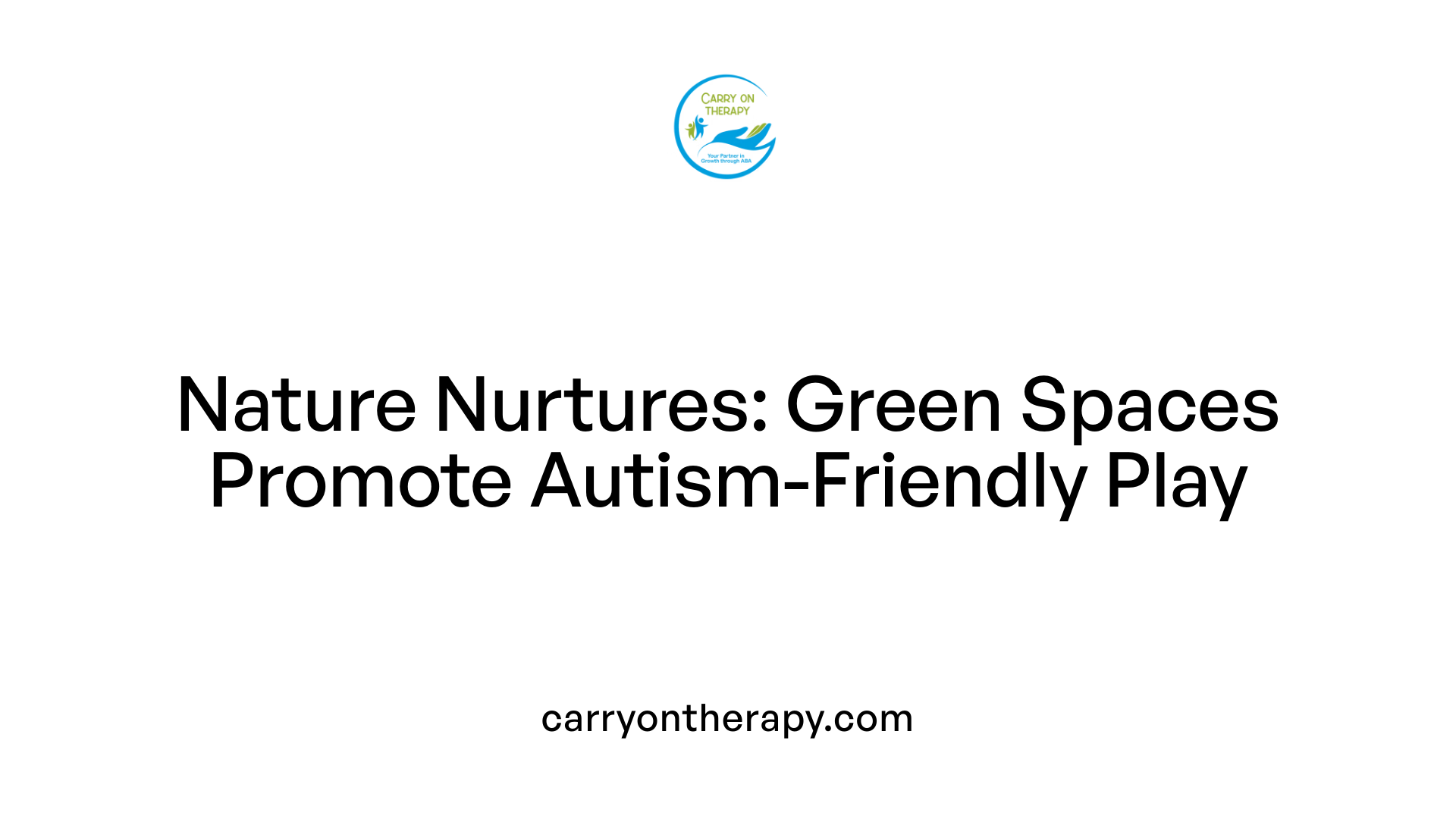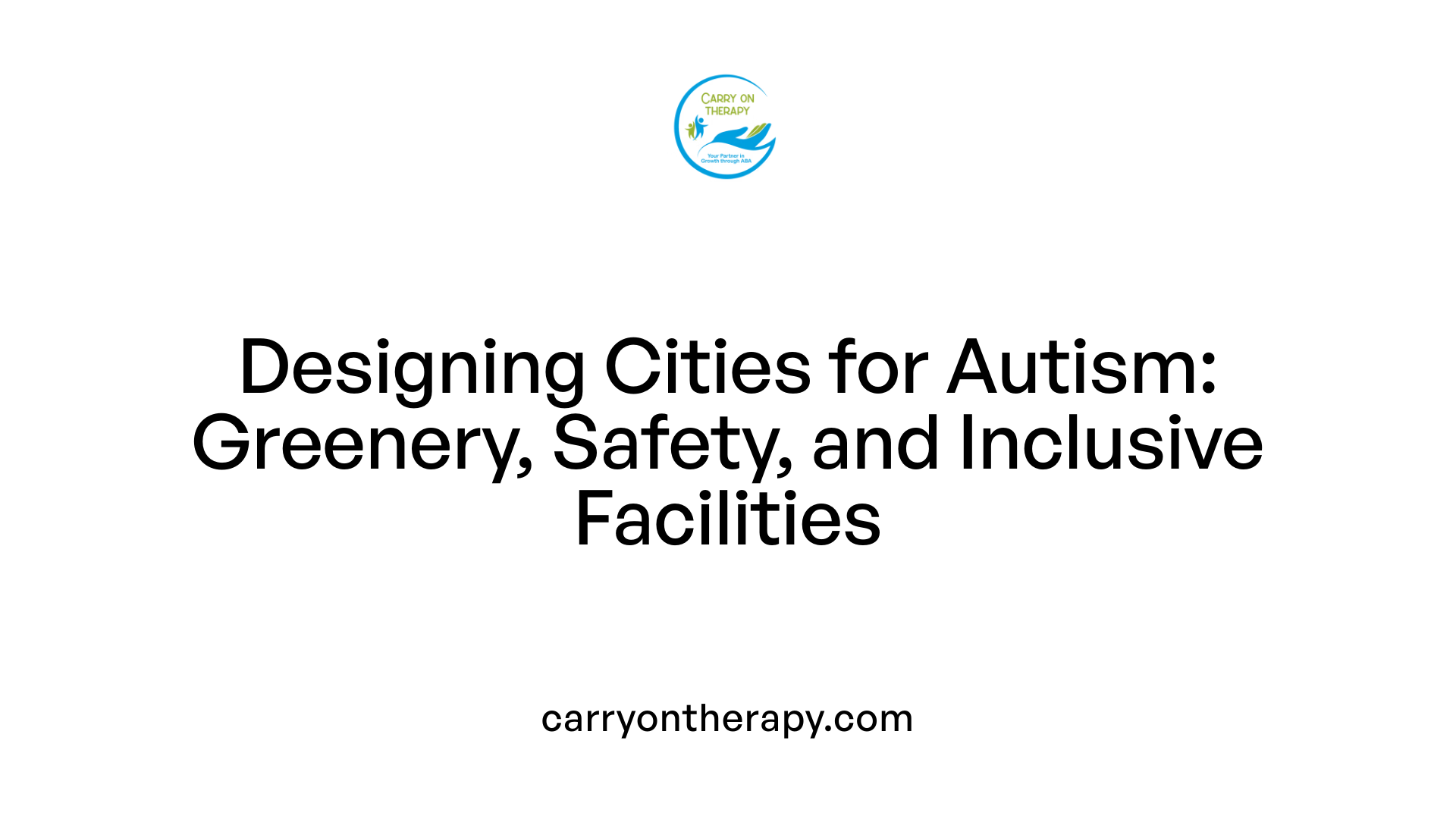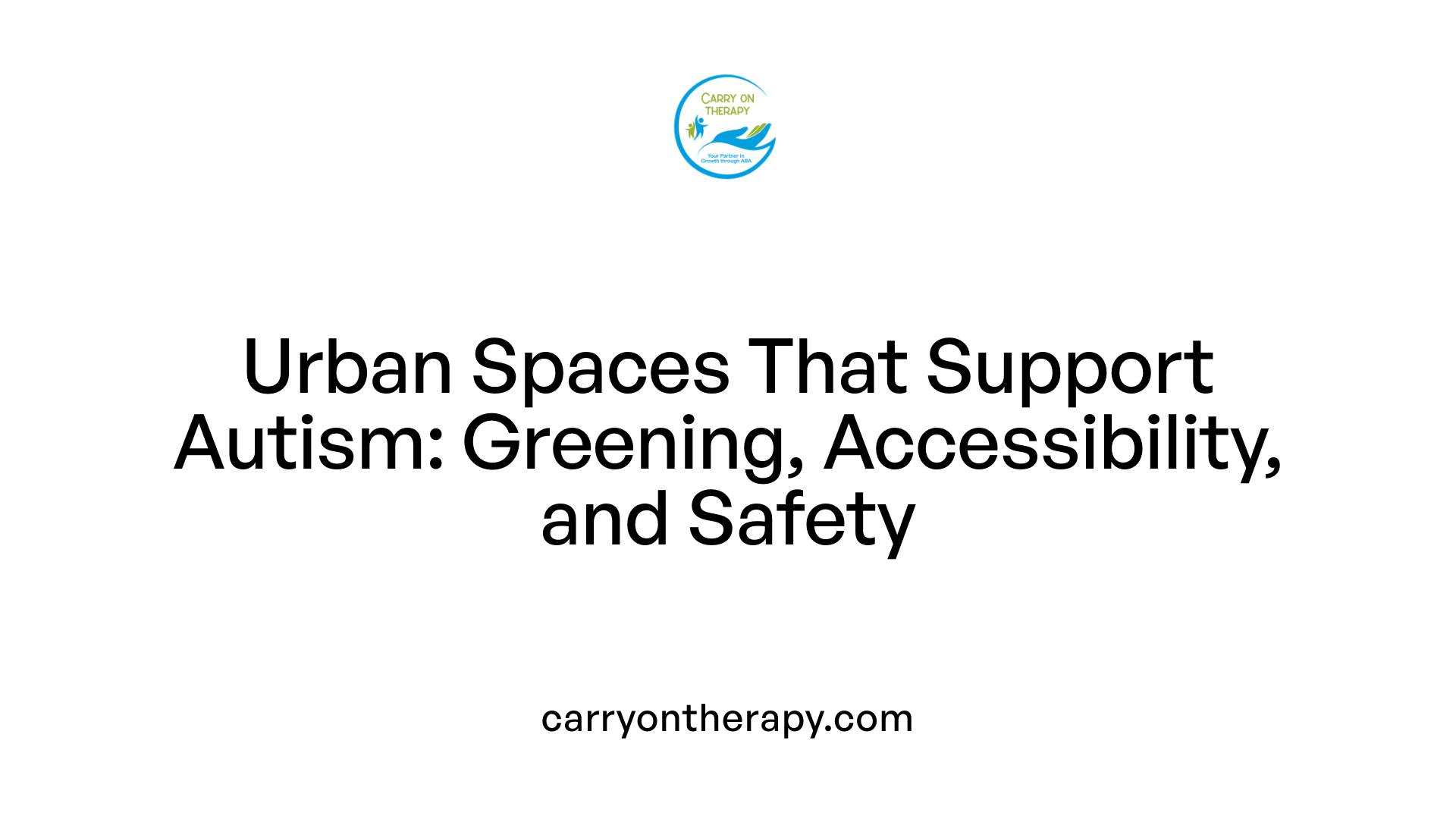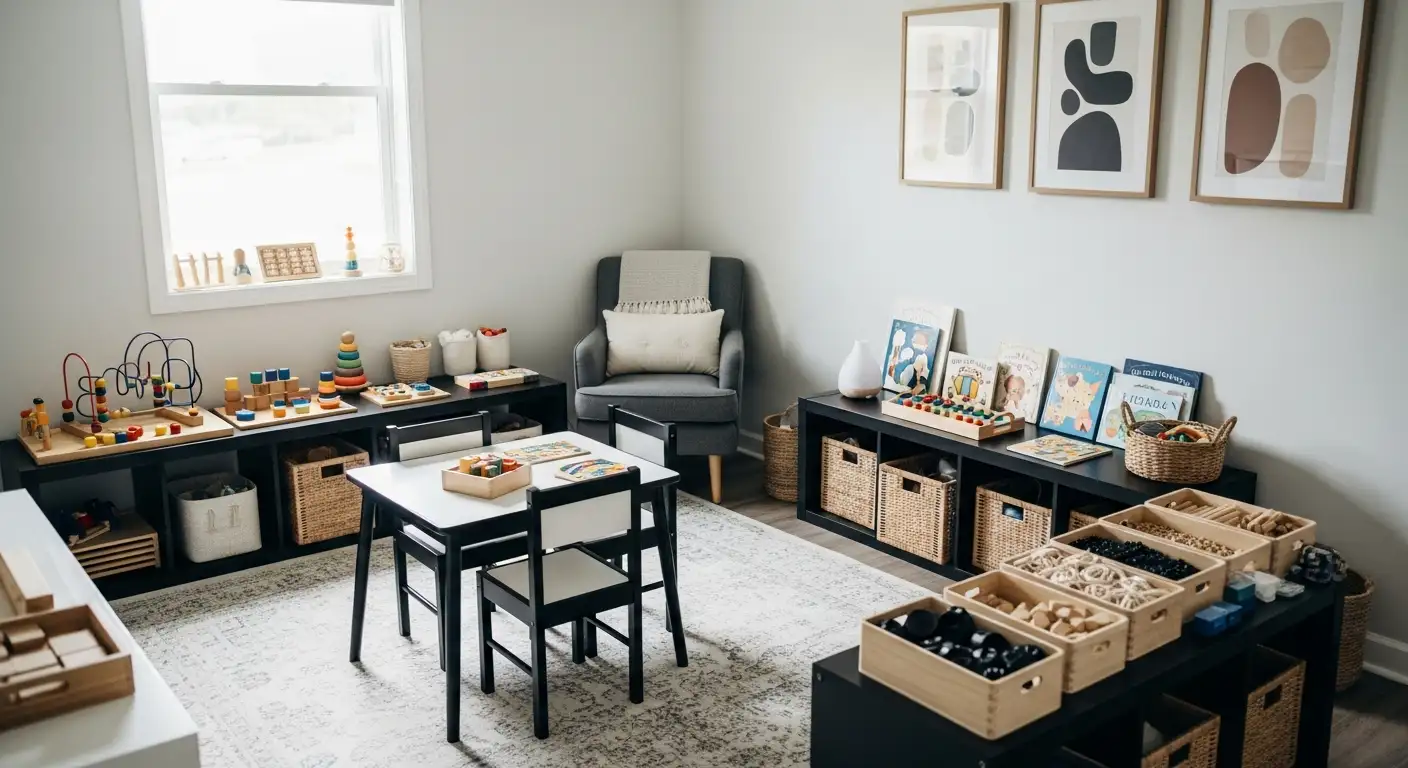Does Living In A City Cause Autism?
Urban Environments and Autism: Exploring the Connections Beyond Causation

Unraveling Myths and Realities About City Living and Autism
The question of whether living in a city causes autism has long intrigued parents, professionals, and researchers alike. While urban environments offer diverse experiences, they also present unique challenges and opportunities for children with autism spectrum disorder (ASD). This article navigates the complex interplay between urban living conditions and autism, with a particular focus on behavioral therapies and environmental influences that shape the lives of children with ASD.
What is Applied Behavior Analysis (ABA) Therapy?
What is Applied Behavior Analysis (ABA) therapy?
Applied Behavior Analysis (ABA) therapy is a science-driven approach to improving behaviors through understanding and modifying the relationships between behaviors and environmental factors. ABA uses principles of learning theory to increase positive behaviors and reduce those that may hinder daily functioning.
Goals and techniques used in ABA
ABA therapy focuses on enhancing essential skills like communication, social interaction, emotional regulation, executive functioning, and daily living tasks. Techniques commonly used include positive reinforcement, discrete trial training, and naturalistic teaching methods. Treatment plans are tailored to each individual's unique needs and developmental level to maximize effectiveness.
Settings and customization of ABA programs
ABA can be delivered in multiple environments such as at home, in schools, or community settings. Programs are customized based on age, skills, and severity of behavioral challenges, often involving parents or caregivers as active participants. Parent-led ABA therapy—with adequate training—has shown strong outcomes in skill acquisition and generalization across natural settings.
Role of Board-Certified Behavior Analysts (BCBAs)
BCBAs are highly trained professionals responsible for assessing individuals, designing and monitoring ABA programs, and making data-driven decisions. Geographic accessibility to BCBAs varies, with higher access in affluent, urban counties, indicating a need for expanded provider recruitment in underserved areas.
Evidence supporting ABA effectiveness for autism
Scientific studies consistently support ABA's effectiveness, especially for children with autism spectrum disorder. Improvements are noted in communication, social skills, emotional control, and adaptive behaviors. The therapy's evidence base and flexibility make it a recommended best practice by major health organizations worldwide.
Who Provides ABA Therapy?
Who provides ABA therapy?
ABA therapy is primarily delivered by licensed and trained professionals specialized in Applied Behavior Analysis. The most prominent among these are Board-Certified Behavior Analysts (BCBAs), who develop and oversee individualized treatment plans tailored to each child's needs. Supporting them are Registered Behavior Technicians (RBTs), who implement these plans directly with children under BCBA supervision.
ABA therapy is offered in various settings, including specialized clinics, schools, homes, and community centers. Specialized clinics and organizations focused on autism spectrum disorder often serve as centralized providers where comprehensive services are available.
Training and certification are critical components to ensuring quality ABA therapy. BCBAs must complete rigorous graduate-level coursework, supervised fieldwork, and pass a certification exam administered by the Behavior Analyst Certification Board. Similarly, RBTs require formal training and ongoing supervision.
Professional oversight is vital for effective therapy delivery. BCBAs continually monitor progress, adjust treatment goals, and provide hands-on supervision to ensure interventions are ethical and evidence-based. This oversight guarantees treatments remain individualized and conducive to skill acquisition and behavioral improvements in children with ASD.
In conclusion, qualified behavioral health professionals with specialized training and certification form the backbone of effective ABA therapy services.
How Does ABA Therapy Benefit Individuals with Autism?
Skill Development Through ABA
Applied Behavior Analysis (ABA) therapy is designed to systematically teach essential skills to individuals with autism spectrum disorder (ASD). These skills include communication, emotional regulation, executive functioning, and social interactions. Studies show that parent-led ABA, especially when parents have at least 40 hours of prior training, can effectively deliver therapy at home. Over a period of 90 days or more, children show meaningful improvements in these areas, highlighting the therapy's focus on personalized skill acquisition.
Behavior Modification Techniques
ABA uses evidence-based methods such as positive reinforcement, prompting, and environmental modifications to encourage desirable behaviors and reduce unwanted ones. By analyzing what happens before and after a behavior, therapists can design interventions that promote play and social engagement while inhibiting avoidance and concealment behaviors common in children with ASD.
Improvement in Communication and Social Skills
Communication and social skills are often core challenges for individuals with autism. Higher utilization of prescribed ABA hours correlates with significant gains in these areas. Children who follow comprehensive treatment plans and younger children (ages 2-5) tend to show more noticeable progress, including better emotional regulation and overall success in social interactions.
Promoting Independence and Community Participation
ABA therapy supports independence by teaching self-help routines and coping skills. It prepares individuals for community participation by fostering confidence through consistent, naturalistic settings, including in-home therapy. This approach overcomes limitations such as workforce shortages and geographic barriers by making therapy more accessible and culturally tailored.
Overall Quality of Life Enhancements
By simultaneously targeting multiple developmental areas and reducing challenging behaviors, ABA therapy enhances an individual's overall quality of life. Effective parent-led ABA fosters a supportive environment that promotes meaningful developmental progress, enabling individuals with autism to lead fuller, more autonomous lives.
Typical Structure of an ABA Therapy Session
What does a typical ABA therapy session involve?
A typical Applied Behavior Analysis (ABA) therapy session is thoughtfully structured to meet the individual needs of a child with autism spectrum disorder (ASD). Each session focuses on developing essential skills such as communication, social interaction, and daily living, while also addressing behaviors that need improvement.
Individualized activity planning
Sessions are tailored to the child's specific goals based on thorough assessments. Activities are planned to target various skill areas, including emotional regulation and executive functioning, ensuring they align with the child's learning needs.
Techniques used during sessions
Therapists apply methods like positive reinforcement, where desirable behaviors are rewarded to encourage repetition. They carefully observe antecedents and consequences — understanding what triggers a behavior and its outcomes — to modify behaviors effectively.
Role of reinforcement and behavioral analysis
Reinforcement is central, increasing play and social behaviors by rewarding progress. Behavioral analysis guides the intervention by using data on behaviors to refine strategies continually.
Data collection and progress monitoring
Ongoing data collection is integral, tracking the child's responses to interventions. This information helps therapists monitor skill acquisition and make data-driven decisions to enhance treatment effectiveness.
Supervision by certified analysts
Sessions are overseen by Board Certified Behavior Analysts (BCBAs) who ensure interventions are evidence-based and personalized. This supervision optimizes therapy outcomes and maintains high standards of care.
This structured approach, supported by trained professionals, facilitates meaningful skill development for children with ASD and adapts to their evolving needs over time.
Urban Living and Autism Prevalence: Debunking Simplistic Causation
Epidemiological views on autism and urban environments
Studies have noted higher diagnosis rates of autism spectrum disorder (ASD) in urban environments compared to rural ones. This observation has often prompted questions about whether city living contributes directly to autism prevalence. However, current research emphasizes that while urban areas show stronger autism diagnosis rates, this does not imply a straightforward causal relationship.
Lack of evidence linking city living as a cause
There is no conclusive evidence that living in an urban setting causes ASD. Instead, the higher prevalence in cities is frequently explained by improved access to diagnostic resources, specialized healthcare facilities, and behavior analyst services that are more concentrated in metropolitan zones.
Socioeconomic and demographic confounders in urban ASD rates
Urban regions typically feature greater socioeconomic diversity, with affluent populations clustering near clinical resources such as Board Certified Behavior Analysts (BCBAs). Data reveal that affluent urban counties have higher access to BCBAs, influencing autism diagnosis and treatment availability. Conversely, poverty and racial-ethnic factors negatively affect access, highlighting that socioeconomic conditions, beyond location alone, shape observed ASD prevalence.
Why urban areas show higher diagnosis rates without causation
The increased diagnosis rates in cities reflect better healthcare infrastructure, higher provider density, and parental awareness rather than urban environmental triggers of ASD. Geographic accessibility to specialized services encourages earlier identification and intervention, which can skew prevalence statistics.
Complexity of autism origins beyond geographical location
Autism is a complex neurodevelopmental condition influenced by genetic, environmental, and social factors. Its roots extend well beyond geographic determinants like urban or rural residency. Studies caution against oversimplifying autism’s origins to mere place of residence, underscoring the need for nuanced examination of contributing elements.
This comprehensive understanding encourages policymakers and researchers to focus on improving equitable healthcare access and tailored interventions across diverse communities rather than associating urban living directly with autism causation.
Impact of Residential Density on Play Behaviors of Children with ASD
How Does Lower Residential Density Affect Play Behavior in Children with ASD?
Lower residential building density has been shown to have a positive effect on the play behavior of children with autism spectrum disorder (ASD). More open and less crowded neighborhoods may provide safer, quieter, and less overstimulating environments that encourage children with ASD to engage more freely in play activities.
What Is the Influence of Crowding on Avoidance and Concealment Behaviors?
Conversely, higher population density at destinations and the presence of many children can trigger avoidance and concealment behaviors in ASD children. Crowded, noisy environments might increase anxiety or sensory overload, leading children to hide or withdraw rather than participate.
How Does Destination Population Density Relate to Play Behaviors?
Though some density is beneficial for social opportunities, excessive density at destinations tends to inhibit active play by promoting concealment and avoidance in ASD children. Finding a balance where social interaction is accessible but not overwhelming is crucial.
How Can Urban Density Be Balanced for Optimal Behavioral Outcomes?
Urban planning aimed at children with ASD can strive for lower residential building density and moderate destination crowding to enhance play behaviors. Combining this with features like ample greening, accessible public and recreational facilities, and safe transportation infrastructure can mitigate stressors related to density and foster better social and play experiences for ASD children.
Role of Urban Green Spaces in Supporting Children with Autism

Benefits of higher residential greening and vegetation coverage
Higher levels of residential greening and vegetation, quantified using indices like NDVI (Normalized Difference Vegetation Index), play a vital role in supporting children with autism spectrum disorder (ASD). Increased greenery is strongly associated with encouraging play behavior and reducing avoidance and concealment actions among ASD children. These behaviors are critical markers of social engagement and emotional comfort, indicating that greenery can positively influence their interaction with surroundings.
Reduction of avoidance and concealed behaviors
Studies have noted that children with ASD display fewer avoidance and concealment behaviors in areas with abundant green spaces. This reduction likely stems from a calming effect green environments provide, helping to decrease stress and anxiety that often trigger such defensive behaviors. Inhibiting these avoidance tendencies allows for greater opportunities for social and play-based interactions.
Use of NDVI for measuring greenery impact
NDVI is an effective remote-sensing measurement tool used to quantify vegetation coverage and assess its quality. By using NDVI data, researchers and planners can objectively evaluate the impact of different levels of greenery on children's behavior in urban settings. This metric helps link measurable environmental features to positive outcomes for ASD children.
How urban greenery encourages social play
Urban green spaces provide natural and inviting environments that promote play, exploration, and socialization. These areas offer sensory-rich stimuli that can engage children with ASD, who often benefit from varied sensory experiences. By fostering play behavior and lowering stress indicators, higher greenery supports the developmental and social needs of these children.
Design implications for urban planners
Urban planners should prioritize integrating expansive and accessible green spaces within residential areas to support the well-being of children with ASD. Considerations include maintaining high vegetation coverage, ensuring safety features, and enhancing the usability of parks to facilitate social play and reduce avoidance. Thoughtful design can create inclusive urban environments that nurture the behavioral and social development of children on the spectrum.
Transportation and Infrastructure Influences on ASD Children's Play
Features of transportation facilities that aid play
Transportation infrastructure plays a vital role in creating an environment where children with Autism Spectrum Disorder (ASD) feel confident and safe to engage in play. Facilities that include well-maintained sidewalks, clearly marked traffic lights, controlled vehicle speeds, and dedicated spaces separating pedestrians from vehicles are particularly supportive. These features reduce traffic-related hazards and anxiety, encouraging children with ASD to explore outdoor play spaces more freely.
Effects of sidewalks, traffic lights, speed limits
Sidewalks provide a designated and safe path for children, facilitating independent movement and social exploration essential for play. Traffic lights regulate movement at intersections, giving children clear cues when it is safe to cross.
Speed limits slow down vehicles near play areas, minimizing risk and creating a calming environment that encourages longer and more frequent play sessions. Together, these elements significantly enhance the likelihood of children with ASD participating in outdoor play activities.
Safety measures enabling freer social interaction
Separating pedestrian pathways from vehicle lanes physically protects children, reducing avoidance behaviors driven by fear of traffic. When children feel secure, they are more inclined to engage with peers and explore their surroundings, which benefits social development.
Accessibility fostering improved play behavior
Easy access to destinations such as parks, playgrounds, and recreational facilities positively impacts play behavior by reducing stress and promoting active engagement. Increased destination accessibility means children with ASD can reach play spaces without undue difficulty, fostering not only more frequent but also richer social play experiences.
In summary, thoughtfully designed transportation infrastructure that prioritizes safety and accessibility forms a foundation for encouraging play and social interaction in children with ASD.
Public and Recreational Facilities Enhancing Social Engagement in ASD

Why are public restrooms and seating important for children with ASD?
Public facilities such as restrooms and resting areas contribute significantly to creating a supportive environment for children with autism spectrum disorder (ASD). These amenities reduce discomfort and stress, encouraging children to feel safe and remain engaged in social settings rather than avoiding or concealing themselves from interactions.
How do recreational facilities support social play in children with ASD?
Recreational facilities designed with the needs of ASD children in mind stimulate active play and social interaction. The presence of diverse play options promotes not only physical activity but also provides opportunities for children to connect with peers, fostering social skills and reducing tendencies to withdraw.
What is the connection between facility availability and avoidance behavior?
Greater availability of public and recreational facilities correlates with decreased avoidance and concealment behaviors in ASD children. When safe and well-equipped spaces are easily accessible, children tend to engage more comfortably in their surroundings, leading to reduced social inhibition.
How does recreational playability influence behavior promotion in ASD?
Recreational playability—the suitability and accessibility of recreational spaces for various play activities—enhances children's willingness to participate. Increased playability encourages children with ASD to explore and interact, supporting the development of social and play behaviors while curbing avoidance tendencies.
In summary, incorporating accessible public restrooms, seating, and varied recreational facilities into community designs plays a crucial role in promoting positive social engagement and play among children with ASD.
Sociodemographic Factors Affecting ASD Children's Play Behavior
How does guardian employment status impact play behavior in children with ASD?
Guardian employment status is a significant factor influencing the play behavior of children with autism spectrum disorder (ASD). Employed guardians may offer different support structures, availability, and resources, which can affect opportunities for social and recreational play. These differences can influence how actively children engage in play and interact with peers.
In what ways do a child's gender and age influence their play behavior?
Both gender and age play key roles in the play patterns of children with ASD. Younger children, especially those aged 2 to 5 years, generally show more progress and engagement during interventions aimed at improving social and play skills. Gender differences might also affect behavior patterns, with some studies suggesting variations in social interactions and play preferences between boys and girls with ASD.
What effects does household income have on play behavior?
Household income impacts access to resources, therapeutic opportunities, and safe play environments for children with ASD. Higher income households often provide more access to quality urban spaces, recreational facilities, and specialized treatments, facilitating better play behavior and social engagement. Conversely, lower-income households may face barriers that limit these opportunities.
How should these sociodemographic factors inform urban planning and therapy for ASD?
Understanding the influence of sociodemographic factors is crucial for urban planners and therapists. Integrating considerations like guardian employment, child age and gender, and household income can guide the development of accessible, inclusive recreational areas and customized therapy programs. Effective urban design with green spaces, safety measures, and recreational facilities tailored to diverse populations enhances play behavior and social inclusion among children with ASD.
Designing Urban Environments to Foster Positive Behaviors in ASD Children

How can green spaces and accessibility be integrated to support ASD children's play behavior?
Lower residential building density and higher vegetation coverage promote play behavior and reduce avoidance in children with autism spectrum disorder (ASD). Residential greening, represented by measures such as NDVI vegetation coverage, inhibits avoidance and concealment behaviors, creating an inviting environment for social interaction and play. In addition, greater destination accessibility encourages play and decreases behaviors related to concealment.
What role do recreational and public facilities play in modifying ASD children's behaviors?
The presence of recreational facilities enhances children's play behavior while limiting avoidance tendencies. Increasing the number and quality of such facilities provides opportunities for enjoyable, engaging activities suited to ASD children's needs. Public facilities like toilets and resting areas contribute by reducing avoidance and hiding, offering safe, accessible spaces that support comfort and autonomy.
How does safety and traffic management influence the experiences of children with ASD in urban settings?
Superior transportation infrastructure—including sidewalks, traffic lights, speed limitations, and separation between pedestrians and vehicles—encourages play by enhancing perceived and actual safety. This network reduces anxiety from traffic risks, fostering greater participation in social play.
Why is collaborative urban planning important, combining urban design with autism therapy insights?
Urban environments designed with considerations of ASD-specific behavioral responses can substantially foster social play. Incorporating therapeutic knowledge such as the benefits of green spaces, accessibility, and safety supports developmental goals. Collaborative planning efforts that include experts in autism intervention and urban design can produce tailored environments promoting communication, emotional regulation, and social skills. Ultimately, these efforts help create inclusive spaces where children with ASD thrive socially and developmentally.
Parent-Led ABA Therapy: A Scalable Alternative to Traditional Models
What Are the Benefits of Parent-Led Interventions?
Parent-led Applied Behavior Analysis (ABA) therapy offers a flexible and effective approach to autism treatment. By involving parents directly, children benefit from consistent, naturalistic learning opportunities in familiar home environments. This method supports goal achievement and fosters improvements in communication, emotional regulation, executive functioning, and social skills.
What Training Requirements Are Needed for Parents?
Parents who receive 40 or more hours of ABA training before starting therapy can deliver effective in-home treatment. Comprehensive training equips them with the necessary skills to implement interventions accurately, resulting in meaningful skill acquisition for their children.
How Does Parent-Led ABA Improve Skill Acquisition in Naturalistic Settings?
Recent findings show that children undergoing parent-led ABA interventions experience significant progress over periods of at least 90 days. Improvements include enhanced social interaction, emotional control, and communication abilities, benefiting especially younger children aged 2 to 5 years who follow comprehensive treatment plans.
How Does This Approach Overcome Geographical and Workforce Barriers?
Parent-led ABA therapy addresses challenges such as clinician shortages and geographic limitations that often restrict access to traditional services. By empowering parents to deliver treatment at home, therapy becomes more accessible, regardless of location, enabling broader reach to underserved populations.
What Are the Cultural Flexibility and In-Home Delivery Advantages?
Delivering ABA in the home allows parents to tailor interventions to their family's cultural context and lifestyle, improving comfort and engagement. This adaptability not only enhances therapy effectiveness but also reduces the burden associated with traveling to clinics, making ongoing treatment more manageable for families.
Effectiveness of Prescribed ABA Treatment Hours Utilization
How Does Utilization of Prescribed ABA Treatment Hours Correlate with Skill Gains?
Research demonstrates a strong positive correlation between the percentage of prescribed Applied Behavior Analysis (ABA) treatment hours utilized and improvements in skill acquisition among children with autism spectrum disorder (ASD). Children receiving a higher proportion of their scheduled treatment hours tend to achieve better developmental outcomes.
What Areas Show Significant Improvement with Greater Treatment Adherence?
Increased adherence to prescribed ABA hours is particularly linked to notable gains in communication skills, social interaction, and emotional regulation. These areas are critical to the overall functioning and quality of life in children with ASD, and consistent treatment engagement enhances progress in these domains.
How Does Treatment Hour Utilization Relate to Overall Success?
Beyond specific skill improvements, higher utilization rates are associated with overall therapy success. This means children who consistently complete their allotted ABA sessions experience broader benefits in executive functioning and social capabilities, contributing to sustained behavioral development.
What Are the Implications for Therapy Planning and Family Compliance?
These findings underscore the importance of encouraging families to maximize their use of prescribed ABA hours. Therapy planning should incorporate strategies to promote adherence, including accessible scheduling, parent training in ABA methods, and support systems that address barriers to participation. Prioritizing treatment hour utilization can optimize clinical outcomes and help children with ASD reach developmental milestones more effectively.
Age and Treatment Plan Intensity: Key Factors in ABA Progress
Why do younger children show greater clinical improvements in ABA therapy?
Younger children, specifically those between 2 to 5 years old, tend to exhibit more significant progress during Applied Behavior Analysis (ABA) treatment. This age range often represents a critical developmental window where early intervention can leverage neuroplasticity effectively, making skill acquisition such as communication and social interaction more responsive.
How does the intensity of the treatment plan impact outcomes?
Children on comprehensive ABA treatment plans, involving more hours and a broader scope of therapy targets, generally achieve better clinical outcomes compared to those on minimal intervention plans. Comprehensive plans allow for more consistent practice and reinforcement of skills, which enhances learning and generalization across settings.
What factors cause variability in progress during ABA therapy?
Progress can vary widely depending on autism severity, adherence to the prescribed treatment hours, and individual child characteristics. Children with higher treatment adherence – measured by the proportion of prescribed hours actually utilized – show more pronounced improvements, particularly in social skills and emotional regulation.
How should therapy be tailored based on age and individual needs?
Therapists and guardians should customize ABA programs by considering the child’s age, developmental level, and specific challenges. For younger children, early, intensive interventions focusing on foundational skills are crucial. For older children or those with more severe symptoms, therapy may need adjustments to intensity and focus areas to maintain engagement and effectiveness.
Optimizing ABA treatment by accounting for both age and treatment intensity can significantly enhance clinical progress and better support children with autism spectrum disorder.
Geographic Distribution of Board Certified Behavior Analysts (BCBAs) in the U.S.
Data Analysis Methodology Using GIS
Researchers employed Geographic Information System (GIS) software to accurately map the distribution of Board Certified Behavior Analysts (BCBAs) across 3,040 counties in 49 U.S. states and Washington D.C. Each BCBA was assigned to a county based on their residence, while children with Autism Spectrum Disorder (ASD) were allocated to counties through their respective school districts. This spatial analysis enabled precise visualization and computation of provider accessibility relative to the ASD population.
County-Level Allocation and Ratios
The study categorized counties based on the ratio of children with ASD to available BCBAs. Categories ranged from counties with no BCBAs to those with a ratio of up to 10 children per BCBA. This approach highlighted disparities in service availability, providing a clear framework to assess how many children potentially share each BCBA's care within different regions.
Variations Between Urban, Affluent, and Rural Counties
Findings revealed that highly affluent and urban counties exhibited substantially higher access to BCBAs, with odds ratios between 2.26 and 5.26. Conversely, rural and less affluent counties faced limited access, often having no or few BCBAs. While county-level poverty was unexpectedly linked with better access in some urban contexts, this was influenced by the degree of urbanicity. Additionally, race-ethnicity and healthcare insurance coverage showed negative associations with BCBA availability, suggesting systemic barriers beyond geography.
Implications for Access and Service Availability
These geographic disparities emphasize the need for targeted recruitment strategies focusing on non-urban and economically disadvantaged counties to improve equity in ABA services. Enhancing BCBA presence in underserved areas could reduce service gaps, facilitating better clinical outcomes for children with ASD nationwide. Strategic expansion of the BCBA workforce is essential for overcoming access limitations driven by socioeconomic and demographic factors.
Socioeconomic and Racial-Ethnic Disparities in BCBA Access
How does access to BCBAs vary by socioeconomic status and urbanicity?
Access to Board Certified Behavior Analysts (BCBAs) is significantly higher in affluent and urban counties. Data analysis shows that these counties have between 2.26 to 5.26 times greater access compared to less affluent or rural areas. This disparity indicates that families living in wealthier urban environments are more likely to find available certified professionals for autism-related services.
What is the relationship between county-level poverty and BCBA access?
Interestingly, county-level poverty shows a positive association with access to BCBAs, but this is moderated by urbanicity. In other words, poorer counties that are urban tend to have better access than rural counties, while rural areas with high poverty may experience limited availability. This suggests that urban infrastructure might help alleviate poverty-related barriers to accessing specialized autism treatments.
How do race-ethnicity and healthcare insurance coverage affect BCBA access?
Race-ethnicity and healthcare insurance coverage are negatively related to BCBA access. Minority groups and those with inadequate or no insurance face greater challenges in obtaining behavioral therapy services. These disparities highlight systemic inequalities beyond geographic and economic factors, reflecting the influence of social determinants and healthcare policies on service availability.
What challenges exist for equitable service delivery?
The uneven distribution of BCBAs poses several challenges for equitable care. Rural and less affluent counties often lack sufficient professionals, worsened by factors such as transportation limitations and fewer healthcare resources. Additionally, disparities based on race and insurance coverage underscore ongoing barriers in reaching vulnerable populations. Addressing these requires strategic recruitment and resource allocation focused on non-urban and underserved areas to close the accessibility gap.
This analysis underscores the multifaceted nature of BCBA accessibility and calls for targeted policy interventions to ensure all children with autism have equitable opportunities for effective therapy.
Strategies to Improve BCBA Access in Non-Urban and Low Affluence Areas
How can provider recruitment be targeted towards underserved regions?
Addressing the shortage of Board Certified Behavior Analysts (BCBAs) in non-urban and low affluence counties requires focused recruitment efforts. These strategies include offering incentives such as loan forgiveness, competitive salaries, and relocation assistance to attract BCBAs to less affluent or rural areas. Additionally, recruiting providers from within these communities can help retain local talent and promote culturally relevant care.
What role can telehealth and remote supervision play?
Telehealth and remote supervision are promising solutions to enhance BCBA access in underserved regions. By leveraging technology, children with autism in rural areas can receive quality Applied Behavior Analysis (ABA) therapy without the need for nearby specialists. This approach overcomes geographic barriers, reduces travel burdens for families, and allows for flexible, in-home interventions guided by trained professionals.
How can community partnerships and training local providers improve access?
Building community partnerships is vital for expanding BCBA services. Collaborations with schools, healthcare providers, and local organizations can facilitate identification and referral of children with autism. Training local providers, including paraprofessionals and parents, empowers communities to deliver parent-led ABA treatment effectively, which has been shown to produce positive clinical outcomes when parents receive adequate training.
What policy initiatives can reduce disparities in BCBA access?
Policy interventions are essential to bridge the gap in BCBA availability. States can implement funding initiatives to support provider recruitment in underserved areas, incentivize telehealth services, and support ABA training programs tailored for rural communities. Additionally, addressing systemic barriers related to healthcare insurance and socio-economic factors can promote equitable access across different populations.
Collectively, these strategies offer scalable and flexible solutions to enhance BCBA availability, ensuring children with autism in all communities receive timely and effective support.
Balancing Urban Advantages and Challenges for Autism Support

Urban resource availability
Urban areas tend to offer enhanced access to specialized autism support resources, such as Board Certified Behavior Analysts (BCBAs). Research indicates that highly affluent and urban counties have significantly higher BCBA availability, facilitating parent-led ABA therapy and professional interventions. Such resources promote skill acquisition in communication, emotional regulation, and social skills, benefiting children with ASD.
Environmental stressors and their mitigation
Despite these advantages, urban environments pose challenges, including high population densities at destinations and crowded public spaces, which can increase avoidance and concealment behaviors in ASD children. Mitigation strategies involve designing urban spaces with increased greenery—demonstrated by higher NDVI vegetation coverage and residential greening—which reduce stress responses and encourage play behaviors. Lower residential building density and thoughtful transport infrastructure (e.g., sidewalks, traffic signals, vehicle speed limits) further create safer, more inviting environments for social interaction.
Community inclusion possibilities
Public and recreational facilities such as accessible toilets and resting areas play vital roles in reducing avoidance behaviors and promoting inclusion. Additionally, ensuring destination accessibility and the presence of more children in community spaces can foster positive social play when balanced correctly. Sociodemographic factors—including guardian employment, household income, child’s age, and gender—also affect social participation levels, highlighting the need for equitable support across diverse communities.
Integrating therapy and urban planning
Urban planning that incorporates natural green spaces, enhanced recreational opportunities, and accessible transportation infrastructure complements therapeutic approaches such as parent-led ABA treatment. Together, these strategies provide scalable, culturally sensitive support to families in urban settings. Prioritizing recruitment of autism service providers in less affluent and non-urban counties can extend these benefits, creating a balanced ecosystem that supports children with ASD both socially and clinically.
Summary: Does Living in a City Cause Autism?
No Direct Causation Found
Current research does not support the idea that living in a city causes autism spectrum disorder (ASD). Instead, urban environments influence behaviors of children with ASD through factors such as residential density, greening, accessibility, and facilities.
Urban Living Affects Social and Play Behavior Through Environment and Resource Access
Lower residential density and higher greenery encourage play and reduce avoidance behaviors in children with ASD. Features like excellent transportation infrastructure, accessible destinations, and ample recreational and public facilities promote social play and reduce concealment.
However, greater population density at destinations can increase avoidance behaviors, highlighting the need for balance in urban planning. Sociodemographic factors such as a child’s age, gender, household income, and guardian employment also influence play behavior.
Therapy Access Disparities Exist Based on Geography and Demographics
Geographic access to Board Certified Behavior Analysts (BCBAs) varies significantly. Affluent and urban counties enjoy better access, while rural and less affluent areas face shortages. Race, ethnicity, and insurance coverage also affect access negatively. This disparity impacts therapy availability and outcomes.
Importance of Thoughtful Urban Planning and Therapy Delivery
Tailoring urban environments with green spaces, safety features, and accessible facilities can enhance social play for ASD children. Meanwhile, parent-led Applied Behavior Analysis (ABA) therapy, especially when parents receive adequate training, offers a scalable alternative that can mitigate geographic and workforce barriers. This approach supports better skill acquisition and clinical outcomes, particularly for younger children.
| Aspect | Influence on ASD Children | Additional Notes |
|---|---|---|
| Residential Density | Lower density promotes play | Balance needed to avoid overcrowding-induced avoidance |
| Greening (NDVI coverage) | Encourages play and reduces avoidance | Green spaces crucial in urban planning |
| Accessibility and Facilities | Enhances play, reduces concealment | Includes transportation, toilets, recreational areas |
| Population Density at Destinations | Higher densities may increase avoidance behaviors | Crowding can be a stressor |
| Therapy Access | Better in affluent, urban counties | Disparities linked to race, insurance, urbanicity |
| Parent-led ABA Therapy | Effective with ≥40 hours training | Offers flexible, in-home option overcoming access barriers |
Conclusions on Urban Living and Autism: Insights Beyond Myths
Living in a city does not cause autism, but the urban environment undeniably shapes the experiences of children with ASD. Factors such as residential density, green spaces, transportation infrastructure, and availability of public and recreational facilities influence behavioral outcomes and social engagement. Access to effective interventions like ABA therapy varies widely, influenced by socioeconomic status and geographic location. Parent-led ABA emerges as a promising model to bridge gaps in therapy provision. The evidence underscores the importance of inclusive urban planning and equitable healthcare delivery in fostering positive development for children on the autism spectrum. Understanding these complexities enables caregivers, therapists, and policymakers to create environments where ASD individuals can thrive, irrespective of their urban or rural residence.
References
- The Impact of the Urban Built Environment on the Play ...
- Parent-Led Applied Behavior Analysis to Impact Clinical ...
- Impact of County Sociodemographic Factors and State ...
- Applied Behavior Analysis (ABA)
- The Top 10 Reasons Children With Autism Deserve ABA
- Applied Behavior Analysis (ABA)
- 6 Benefits of ABA Therapy for Children with Autism







